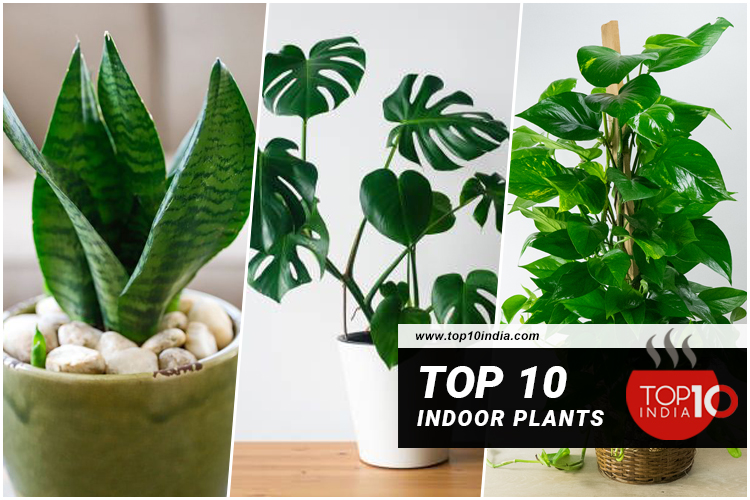Top 10 Indoor Plants | Experiencing All The Healthy Benefits: There are a few things that can take your home to the next level and prove you’re a real adult: a bookshelf, a bar cart, and perhaps most of all, an indoor plant. But let’s be real—most people aren’t planting experts and have no idea where to start. We go to our local big box stores, and we buy up whatever looks pretty,” says Stephanie Horton, professional “plant lady” and creator of the botanical black girl Instagram. “Then, we get them home, and we try to figure it out.”
Top 10 Indoor Plants
“While there are many plants marketed as ‘indoor plants,’ all plants are native to being outside in some realm,” says Horton. Not only should you take stock of how much light your home receives throughout the day, but the direction your windows face. In this article, we are going to discuss the top 10 Indoor plants in India. These pants are easily available and have a good refreshing rate. Add these indoor plants to your home, and you’ll start experiencing all the healthy benefits ASAP. Here is the list below of the top 10 Indoor plants in India.
No.1 Snake Plant
Don’t let the name fool (or, more likely, scare the crap out of) you. Marino explains that the snake plant gets its name from the thin, upright leaves with “irregular green banding” that look like—you guessed it—snakeskin. Besides looking cool, it’s a low-maintenance plant that’s known for surviving droughts, making it perfect for newbies living in almost any environment. “Although the snake plant prefers bright light, it can survive lower light levels,” she adds. Snake plants have also been shown to filter out nasty chemicals, like benzene, formaldehyde, trichloroethylene, xylene, and toluene, so that you can breathe easy having this in your home.
No.2 Monstera Delicosa
These trendy plants are one of Horton’s faves not just because their eye-catching look is oh-so-Grammarly, but because “once you get them going, they’re easy growing.” Especially during the warmer season, expect to see a new leaf weekly. Plus, you can easily propagate them (a.k.a. split off a leaf with a node and give it to a friend to grow their own).In general, large-leafed philodendron plants, including the monstera deliciosa, were shown to be one of the most effective at reducing air pollutants, like benzene, trichloroethylene, and formaldehyde.
No.3 Pothos
“Sometimes referred to as the ‘cubicle plant,’ the pothos is a great pick if you’re a self-proclaimed ‘black thumb,’ says Marino. (So that you know, a ‘black thumb’ is the total opposite of a ‘green thumb.’) And while this plant starts small, its trailing vines can grow to over 10 feet long (WOW), even indoors where lower light and dry air make conditions less than ideal. This plant is super easy to grow, adds Marino, and propagates (translation: breeds more pothos) in water. While you’ll need to learn how to propagate a pothos plant, you can basically get as many plants as you want for the price of one. And like the snake plant, the pothos filters benzene, formaldehyde, xylene, and toluene.
No.4 Draceana
If you live a high-maintenance life—always on the go, out at all hours—you need an “easy-going, low-maintenance plant, like the Dracaena,” says Juliette Vassilkioti, co-founder and president of My City Plants. The Dracaena is great. She explains it can easily adapt to different light environments, though it’s best to keep it away from direct sun. The hardiest of these groups is Dracaena Lisa,” she explains. “It can deal with indoor temperature and season changes better than others.” When it comes to purifying the air, though, the Dracaena Marginata Plant is your best bet. It removes benzene, formaldehyde, trichloroethylene, and xylene.
No.5 ZZ Plant
If you live in a lower-light environment, Marino and Horton suggest getting a ZZ Plant because they’re drought tolerant and deficient maintenance. You might notice the ZZ has large potato-like rhizomes (a.k.a. horizontal stems that continuously grow) under the surface of its surrounding potting mix. These rhizomes, Horton explains, are “hearty,” storing water that helps the plant survive drought in its natural environment. She recommends watering it once a month during the growing season (spring and summer) and once every two months when it goes dormant in the fall. “It’s a great plant to have if you’re somebody who happens to travel a lot,” Horton adds.
No.6 Spider Plant
According to Marino, plants that give off “instant jungle vibes,” like the spider plant, are having a serious moment right now. And they’re super easy to care for, says Vassilkioti. These plants need bright light but no direct sun, so they’re perfect to put in a room with big windows. Just keep it away from the windowsill. Vassilkioti adds that this plant is fun to have around because it grows “baby spiders” (spiderettes), which can be easily propagated. It’s also a strong air purifier, removing both formaldehyde and xylene.
No.7 Rubber Tree
If you have a tendency to forget about your plants, or are new to the whole “plant parent” lifestyle, get a rubber tree. According to Vassilkioti, they’re “tolerant to some degree of neglect” (phew) and “handle under-watering better than over-watering.” A rubber tree needs bright light (can take some partial sunlight) and a good amount of space around for it to be happy, grow, and remove carbon dioxide from your home. This tree is ranked in the 7th position in the list of top 10 Indoor plants.
No.8 Bird’s Nest Fern
Having a bird’s nest fern in your home is an instant conversation starter, thanks to its bright green, ripple-edged fronds. You’ll score major cool points with this signature-looking plant, especially if you put it in a hanging planter, as Marino recommends. Because the bird’s nest fern thrives in medium indirect light and a humid environment, Marino says, “it would do great in a bathroom with a shower, as long as there are windows that receive natural light.”
No.9 Peace Lily
If you already have experience keeping an indoor plant alive (congrats), then it might be time to add a peace lily into the mix. Vassilkioti says this one requires more attention compared to other indoor plants. That means keeping it moist without over-watering and placing it in a bright but shady spot, she explains. The peace lily’s flowers have pollen, so this plant might not be the best choice for people who struggle with allergies,” says Vassilkioti. It produces oxygen at night, while most other plants do that during the day. Besides producing oxygen, this plant also removes ammonia, benzene, formaldehyde, and trichloroethylene.
No.10 Philodendron Green
“In the right indoor conditions, the philodendron’s heart-shaped leaves and trailing vines can grow to over 10 feet long, like the pothos,” says Marino. This makes it a great plant if you’ve got high shelves or want to add a hanging planter to your home decor. Also, like the pothos, it’s “straightforward to prune and propagate if you prefer a more compact shape,” she adds. It’s also one of the easiest houseplants to grow. This plant is ranked in the 10th position in the list of top 10 Indoor plants.
Final Thought
Based on research, here is the list of the top 10 Indoor plants. And, if you don’t live in an area blossoming with boutique plant shops with specialists to guide you through the new plant parent process, Horton suggests buying from small businesses online, like The Sill, Tennesse Tropicals, Plant Proper, Botanica, and more.
Please stay connected with us for further updates. We will be keeping you updated from time to time.
















Be First to Comment